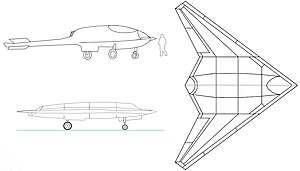Contents
The Hongdu GJ-11 Sharp Sword (Chinese: 攻击-11 利剑; pinyin: gongji-11 lì jiàn) is an unmanned combat aerial vehicle developed in the People's Republic of China for the People's Liberation Army. It was designed by Shenyang Aircraft Design Institute and Hongdu Aviation Industry Group (HAIG),[3] with the latter being the manufacturer.[4] The GJ-11 can perform precision strike and aerial reconnaissance missions.[3][5]

Design
The GJ-11 is a tailless flying wing[3] with two internal weapons bays.[6][3] Stealth features include the shaping of the rear airframe around the engine exhaust[5] and serrated weapon bay doors.[6] The aircraft is powered by a single turbofan engine of an unknown type, and the overall wingspan is 14 meters.[7]
Development
Early versions were less stealthy with an exposed engine nozzle.[8]
Images of the aircraft's first flight appeared on the internet in November 2013.[4]
In October 2021, Aviation Industry Corp of China (AVIC) showcased the GJ-11 at Airshow China. The drone is reportedly capable of taking off autonomously from Type 075 amphibious assault ships. The stealthy drone could deploy swarming air-launched decoys or electronic warfare systems, in addition to launching precision-guided munitions.[9][10]
In October 2022, Chinese media showcased the computer-generated concepts of three GJ-11 being controlled by a two-seat variant of the Chengdu J-20 fighter jet, akin to the Loyal Wingman program of the United States.[11]
Specifications

General characteristics
- Crew: None
- Length: 12.2[6] m (40 ft 0 in)
- Wingspan: 14.4[6] m (47 ft 3 in)
- Height: 2.7[6] m (8 ft 10 in)
- Powerplant: 1 × unnamed Guizhou-built[12] turbofan
Performance
Armament
References
- ^ Thompson, Drew (7 June 2021). Asia-Pacific Regional Security Assessment 2021. Routledge. p. 242. ISBN 978-1-000-47449-7.
- ^ Thompson 2021, p. 244.
- ^ a b c d e Wood, Peter; Cliff, Roger (November 2020). Chinese Airborne C4ISR. United States Department of the Air Force China Aerospace Studies Institute. p. 21. ISBN 9798583085569.
- ^ a b Axe, David (21 November 2013). "Now China's Got a Stealthy Killer Drone". medium.com. war-is-boring. Retrieved 21 November 2013.
- ^ a b Williams, Ian; Dahlgren, Masao (16 October 2019). "More Than Missiles: China Previews its New Way of War". Center for Strategic and International Studies. Retrieved 11 December 2022.
- ^ a b c d e f "歼20性能数据首次披露:最大飞行速度2马赫". Xinhua (in Chinese). 2021-09-28. Archived from the original on 2021-09-29. Retrieved 2021-09-29.
- ^ "GJ-11 UAV displayed on Chinese National Day". air recognition. 3 October 2022.
- ^ Trimble, Stephen (21 May 2013). "New tailless UAV design proclaims Chinese ambition". Flight International. Gale General OneFile. Retrieved 11 December 2022.
- ^ Trevithick, Joseph (11 October 2021). "Chinese Flying Wing Drones Launch Swarming Decoys At Enemy Warships In Industry Video". The Drive.
- ^ Paleja, Ameya (11 October 2021). "China Unveils Long-Range GJ-11 Drones That Can Launch Decoys At Enemy Warships". Interesting Engineering.
- ^ Meier, Ricardo (12 October 2022). "Chinese two-seat J-20 fighter jet controlling three GJ-11 stealth drones". Air Data News.
- ^ "航空报国酬壮志 长天映照赤子心——记贵州航空发动机研究所副总设计师韩冬". 中工网. 2015-04-27. Archived from the original on 2015-09-23.

